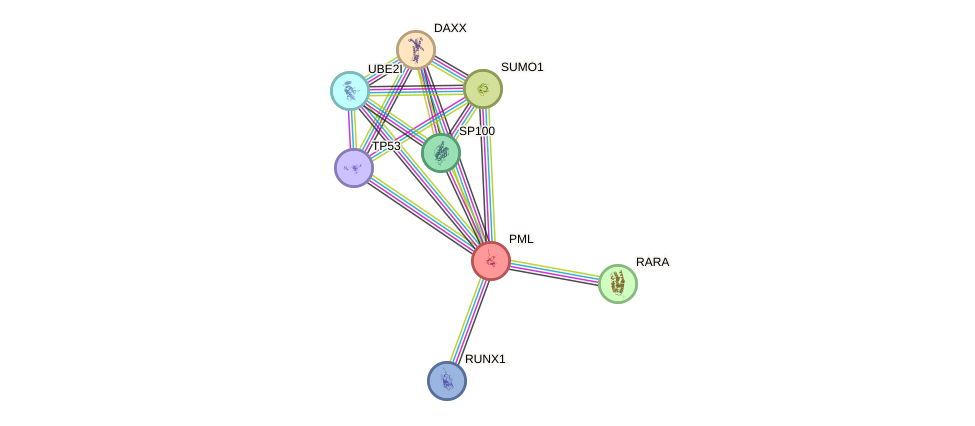GenAge entry for PML (Homo sapiens)
Gene name (HAGRID: 96)
- HGNC symbol
- PML
- Aliases
- MYL; TRIM19; RNF71
- Common name
- promyelocytic leukemia
Potential relevance to the human ageing process
- Main reason for selection
- Entry selected based on evidence directly linking the gene product to ageing in a cellular model system
- Description
The PML gene encodes a number of transcripts and can function as a transcription factor. It is likely oncogenic and may act as a tumour suppressor [518]. PML also appears to control cell proliferation and cellular senescence [517], though its role, if any, in human ageing is unknown.
Cytogenetic information
- Cytogenetic band
- 15q22
- Location
- 73,994,673 bp to 74,047,814 bp
- Orientation
- Plus strand
Protein information
- Gene Ontology
-
Process: GO:0001666; response to hypoxia
GO:0001932; regulation of protein phosphorylation
GO:0006351; transcription, DNA-templated
GO:0006355; regulation of transcription, DNA-templated
GO:0006461; protein complex assembly
GO:0006919; activation of cysteine-type endopeptidase activity involved in apoptotic process
GO:0006977; DNA damage response, signal transduction by p53 class mediator resulting in cell cycle arrest
GO:0007050; cell cycle arrest
GO:0007179; transforming growth factor beta receptor signaling pathway
GO:0007182; common-partner SMAD protein phosphorylation
GO:0007184; SMAD protein import into nucleus
GO:0008285; negative regulation of cell proliferation
GO:0008631; intrinsic apoptotic signaling pathway in response to oxidative stress
GO:0009411; response to UV
GO:0010332; response to gamma radiation
GO:0010522; regulation of calcium ion transport into cytosol
GO:0010761; fibroblast migration
GO:0016525; negative regulation of angiogenesis
GO:0016925; protein sumoylation
GO:0030099; myeloid cell differentiation
GO:0030155; regulation of cell adhesion
GO:0030308; negative regulation of cell growth
GO:0030578; PML body organization
GO:0032206; positive regulation of telomere maintenance
GO:0032469; endoplasmic reticulum calcium ion homeostasis
GO:0032922; circadian regulation of gene expression
GO:0034097; response to cytokine
GO:0042752; regulation of circadian rhythm
GO:0042771; intrinsic apoptotic signaling pathway in response to DNA damage by p53 class mediator
GO:0043153; entrainment of circadian clock by photoperiod
GO:0043161; proteasome-mediated ubiquitin-dependent protein catabolic process
GO:0045087; innate immune response
GO:0045165; cell fate commitment
GO:0045345; positive regulation of MHC class I biosynthetic process
GO:0045892; negative regulation of transcription, DNA-templated
GO:0045944; positive regulation of transcription from RNA polymerase II promoter
GO:0048146; positive regulation of fibroblast proliferation
GO:0048384; retinoic acid receptor signaling pathway
GO:0050713; negative regulation of interleukin-1 beta secretion
GO:0051457; maintenance of protein location in nucleus
GO:0051607; defense response to virus
GO:0060333; interferon-gamma-mediated signaling pathway
GO:0060444; branching involved in mammary gland duct morphogenesis
GO:0070059; intrinsic apoptotic signaling pathway in response to endoplasmic reticulum stress
GO:0071353; cellular response to interleukin-4
GO:0090398; cellular senescence
GO:0097191; extrinsic apoptotic signaling pathway
GO:1901796; regulation of signal transduction by p53 class mediator
GO:1902187; negative regulation of viral release from host cell
GO:2000059; negative regulation of protein ubiquitination involved in ubiquitin-dependent protein catabolic process
GO:2000779; regulation of double-strand break repair
GO:2001238; positive regulation of extrinsic apoptotic signaling pathway
Cellular component: GO:0000784; nuclear chromosome, telomeric region
GO:0005634; nucleus
GO:0005654; nucleoplasm
GO:0005730; nucleolus
GO:0005737; cytoplasm
GO:0005829; cytosol
GO:0016363; nuclear matrix
GO:0016605; PML body
GO:0031901; early endosome membrane
GO:0031965; nuclear membrane
GO:0042406; extrinsic component of endoplasmic reticulum membrane
Hide GO termsFunction: GO:0003677; DNA binding
GO:0005515; protein binding
GO:0008270; zinc ion binding
GO:0031625; ubiquitin protein ligase binding
GO:0032183; SUMO binding
GO:0042803; protein homodimerization activity
GO:0046332; SMAD binding
Protein interactions and network
- Protein-protein interacting partners in GenAge
- TP53, TERT, WRN, LMNA, STAT3, HDAC3, MYC, EGFR, NCOR1, FOS, PIN1, CREBBP, BCL2, NR3C1, TOP2B, NFKB1, RAD51, UBE2I, PML, HTT, FAS, RB1, FOXO1, RELA, SIRT1, HDAC1, SP1, JUN, MAPK3, ATF2, SIN3A, CDK1, HDAC2, MDM2, SUMO1, H2AFX, MTOR, CTNNB1, CDKN2A, TP63, CHEK2, PPARGC1A, PPARG, NCOR2, SQSTM1
- STRING interaction network
Retrieve sequences for PML
Homologs in model organisms
In other databases
- CellAge
- This gene is present as PML

